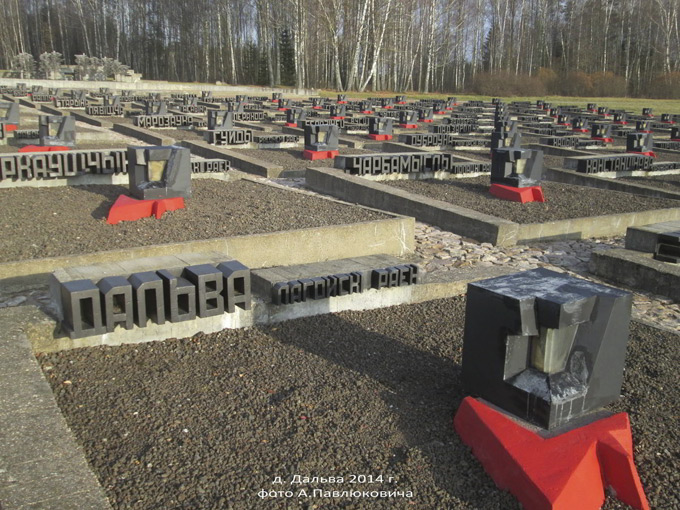Dalva – Sister of Khatyn
From the very beginning of the Second World War, the village of Dalva found itself in the enemy’s rear. The men had gone to the front or to the partisans, only old people, women and children remained in the village.
The tragedy in the village happened on the 19th of June 1944. On the eve of the coming of the Red Army the Nazi occupiers burned Dalva together with its inhabitants.
Early in the morning, the covered trucks with a punitive squad came out of the woods from the neighbouring village of Zherdyazhie and stopped at the outskirts of Dalva. The Nazis surrounded the village in a tight ring, drove all the inhabitants to the outskirts and locked them in the house of Vasil Kucharenok. They threw a grenade into the house and set it on fire. Those who tried to escape through the burning roof were shot by Nazis with submachine guns. After killing the civilians, the executioners set fire to the village from both sides.
Forty-four people died in the flames of the fire: 29 children, 13 women and 2 men. The eldest of the dead was eighty years old. And the youngest, Kostya Kuharenok, was about two. Along with the Dalva villagers, a boy and a girl from other villages were burned: Yuzik Grin from Dedelovichy, who helped a relative with the housework, and Olya Falkovich from Vyazovshchyna, who the day before, on Sunday, came to visit her friend.
By a miracle, 13-year-old Kolya Girilovich survived, who at dawn led his horse to the meadow behind the village. His mother, father, and brothers died in the fire… As an adult, he left his poignant memories of the events of that terrible day in his book “Dalva – Sister of Khatyn” (first published in 1977).
On June 29, ten days after the tragedy, Red Army units marched into the area. Residents from the surrounding villages came to the site of the tragedy, as well as partisans, to bury the remains of the burned villagers of Dalva.
Three wooden crosses of different heights were erected at the site of the tragedy: for the eldest, middle and youngest generations of the burned villagers. The common grave was surrounded with a wooden fence. Later a memorial obelisk was erected on it.
On July 15, 1973, a Memorial Complex was opened in the place of the burned village of Dalva in the Logoisk district of the Minsk region (author Vladimir Terebun). In the center of the composition is the sculpture “Mother and Child”. The wall of memory lists the names and ages of all the dead residents.
Along the former street there are five symbolic log cabins made of concrete. On the porch of each log cabin there are sculptural compositions of various objects of peaceful life: tools of a carpenter, a sickle, a jug for milk, a doll, a primer.
The memory of the villagers is also immortalized on the memorial slabs of the Khatyn necropolis.
Documents on the tragedy of Dalva and the commemoration of its inhabitants are stored in the National Archives of the Republic of Belarus. A number of materials were published in the archival collections “Tragedy of Belarusian Villages” (2011) and “Khatyn Necropolis” (2014), as well as posted in the open access within the framework of the archive Internet project – the database “Belarusian Villages Burned during the Great Patriotic War”.





